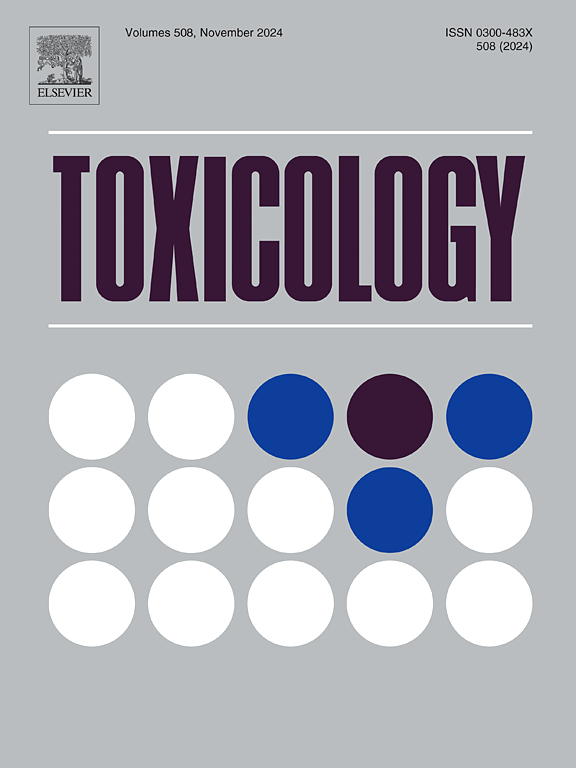A mechanistically-anchored and human stem cell-based in vitro test battery for assessing liver steatogenic potential of chemicals
IF 4.6
3区 医学
Q1 PHARMACOLOGY & PHARMACY
引用次数: 0
Abstract
Fatty liver disease, which can result from various factors including chemical exposure, is an increasing clinical concern. A key event in its development is steatosis, referring to the accumulation of lipids within hepatocytes. To enable early detection of chemical-induced liver steatosis, we developed a mechanistically-anchored, human-relevant new approach methodology (NAM). This NAM consists of a 2-tiered in vitro test battery, aligned with the adverse outcome pathway (AOP) network for steatosis, and utilizes human skin-derived precursor cells differentiated into hepatic cells (hSKP-HPC), previously shown to be responsive to steatogenic triggers. In total, 6 well-known steatogenic compounds, including 3 pharmaceuticals (sodium valproate, tetracycline hydrochloride, amiodarone hydrochloride), a pesticide (cyproconazole), and 2 plasticizers (tricresyl phosphate and perfluorohexanesulfonic acid) alongside 2 non-steatogenic chemicals (minocycline hydrochloride and tartaric acid), were tested over a 72-hour period. Tier 1 evaluated transcriptional changes in key lipid metabolism pathways, and modulations were observed in nuclear receptors (peroxisome proliferator-activated receptor), fatty acid uptake (fatty acid translocase), de novo lipogenesis (diacylglycerol acyl transferase 2, fatty acid synthase and stearoyl-CoA desaturase 1), as well as in VLDL secretion (apolipoprotein B100). Tier 2 assays assessed and confirmed downstream functional disruptions in fatty acid uptake and lipid accumulation as ultimate specific key events for steatogenic chemicals. Overall, this human stem cell-based NAM offers a promising tool for supporting early hazard identification of steatogenic chemicals across diverse sectors, bridging mechanistic insights to outcomes relevant to the initiation of fatty liver disease.
一种机械锚定和基于人类干细胞的体外测试电池,用于评估化学物质的肝脏致脂肪潜能。
脂肪肝可由包括化学物质暴露在内的多种因素引起,是临床日益关注的问题。其发展的一个关键事件是脂肪变性,指的是肝细胞内脂质的积累。为了能够早期检测化学诱导的肝脏脂肪变性,我们开发了一种机械锚定的、与人类相关的新方法方法(NAM)。该NAM包括一个2层的体外测试电池,与脂肪变性的不良结果通路(AOP)网络一致,并利用人类皮肤来源的分化为肝细胞的前体细胞(hSKP-HPC),该细胞先前被证明对脂肪形成的触发因素有反应。总共测试了6种众所周知的致脂肪化合物,包括3种药物(丙戊酸钠、盐酸四环素、盐酸胺碘酮)、一种农药(环丙康唑)、2种增塑剂(磷酸三甲酰基和全氟己磺酸)以及2种非致脂肪化学品(盐酸米诺环素和酒石酸),在72小时内进行了测试。Tier 1评估了关键脂质代谢途径的转录变化,并在核受体(过氧化物酶体增殖激活受体)、脂肪酸摄取(脂肪酸转位酶)、新生脂肪生成(二酰基甘油酰基转移酶2、脂肪酸合成酶和硬脂酰辅酶a去饱和酶1)以及VLDL分泌(载脂蛋白B100)中观察到调节。二级分析评估并确认了脂肪酸摄取和脂质积累的下游功能中断是致脂性化学物质的最终特定关键事件。总的来说,这种基于人类干细胞的不结盟运动提供了一个很有前途的工具,用于支持不同部门的致脂性化学物质的早期危害识别,将机制见解与脂肪肝发病相关的结果联系起来。
本文章由计算机程序翻译,如有差异,请以英文原文为准。
求助全文
约1分钟内获得全文
求助全文
来源期刊

Toxicology
医学-毒理学
CiteScore
7.80
自引率
4.40%
发文量
222
审稿时长
23 days
期刊介绍:
Toxicology is an international, peer-reviewed journal that publishes only the highest quality original scientific research and critical reviews describing hypothesis-based investigations into mechanisms of toxicity associated with exposures to xenobiotic chemicals, particularly as it relates to human health. In this respect "mechanisms" is defined on both the macro (e.g. physiological, biological, kinetic, species, sex, etc.) and molecular (genomic, transcriptomic, metabolic, etc.) scale. Emphasis is placed on findings that identify novel hazards and that can be extrapolated to exposures and mechanisms that are relevant to estimating human risk. Toxicology also publishes brief communications, personal commentaries and opinion articles, as well as concise expert reviews on contemporary topics. All research and review articles published in Toxicology are subject to rigorous peer review. Authors are asked to contact the Editor-in-Chief prior to submitting review articles or commentaries for consideration for publication in Toxicology.
 求助内容:
求助内容: 应助结果提醒方式:
应助结果提醒方式:


